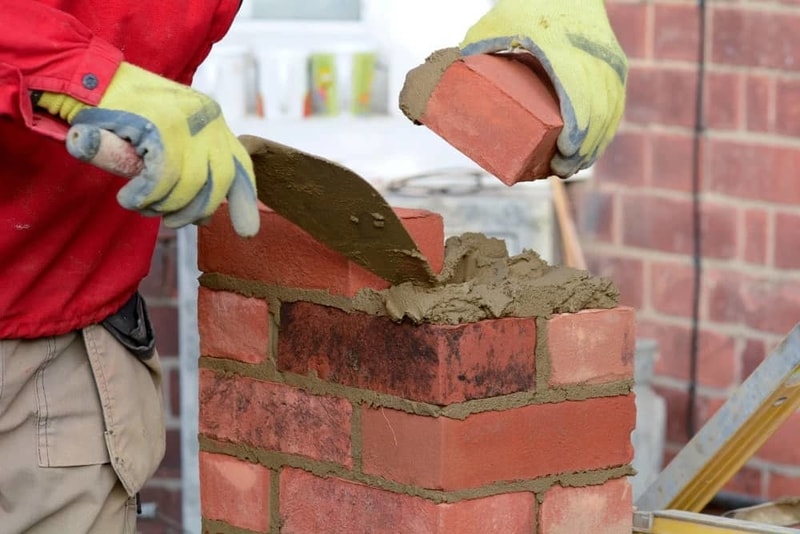Some Known Facts About Bricklayer Auckland.
Wiki Article
The 7-Minute Rule for Bricklayer Auckland
Table of ContentsNot known Facts About Bricklayer Auckland8 Easy Facts About Bricklayer Auckland DescribedBricklayer Auckland Things To Know Before You BuyThe 8-Minute Rule for Bricklayer AucklandThe 20-Second Trick For Bricklayer AucklandSome Known Details About Bricklayer Auckland
Bricks should constantly be stacked on slabs; never stack them directly on irregular or soft ground. Do not save blocks on scaffolds or runways.Other than where stacked in sheds, block heaps should never be more than 7 feet high. When a pile of brick reaches an elevation of 4 feet, it must be tapered back 1 inch in every foot of height above the 4-foot level. The tops of brick piles have to be kept degree, and also the taper need to be maintained during unpiling procedures.
Architectural bond describes how the specific masonry systems interlock or connect together into a single architectural system. You can accomplish structural bonding of block and also tile walls in among the adhering to three means: Overlapping (interlocking) the masonry units. Embedding steel incorporate connecting joints. Making use of grout to adhere adjacent wythes of masonry.
Bricklayer Auckland Fundamentals Explained
Pattern bond refers to the pattern developed by the stonework devices and mortar joints on the face of a wall surface (Bricklayer Auckland). The pattern might arise from the architectural bond, or it might be purely ornamental and unconnected to the structural bond. Number 4-4 reveals the six fundamental pattern bonds in common use today.The running bond is the simplest of the six patterns, being composed of all stretchers. Because the bond has no headers, steel connections typically form the architectural bond. The running bond is made use of largely in tooth cavity wall building and construction, brick veneer wall surfaces, as well as encountering ceramic tile wall surfaces made with extra vast stretcher tile.
Great blocks must not degenerate when put in water. Only when fat lime or clay mortar is made use of or when one is required to make use of bricks that are not well scorched, this soaking rule has actually to be unwinded.
Some Known Factual Statements About Bricklayer Auckland
In all cases, blocks should not be managed in baskets or in any type of various other mode which will certainly ruin the intensity of their edges. A layer of mortar is spread to cover the full width of the wall surface for a suitable size of the lower program.
We press the side protruding mortar in strongly to be level with the face of the wall surface if it is to be left unplastered. In the typical read what he said method adopted by numerous masons, a row of bricks is first positioned on a thin layer of bed mortar leaving the cross joints vacant.


Strictly this is not a good technique. (However, when utilizing concrete mortar of high strength, the loss of stamina because of offense of these guidelines might be only minimal.)The wall surfaces are elevated really plumb. All training courses are laid really horizontal and also all upright joints absolutely vertical. Vertical joints in alternative programs should come straight, one over the various other.
Fascination About Bricklayer Auckland
For this purpose, a wood straight edge with college graduation offering a thickness of each brick program including joint can be utilized for assistance. For a thick wall, the above operation is repeated along with both faces of the wall as well as the interior loading blocks for the thick wall surface are laid in a comparable manner.
This procedure of filling up open joints is described flushing-up. It is mistakenly left out for a number of training courses on some badly-executed jobs as well as only done afterwards (not after every training course) in an ineffective fashion. It is not a great technique as well as anonymous should be avoided as it is necessary that every course ought to be purged up to the level if excellent work is needed.

Bricklayer Auckland Can Be Fun For Everyone
The mortar climbing as well as filling the upright joints totally and creates an extremely strong and also strong wall surface. This is known as larrying. For a rat catch bond work (as in the building of cavity wall surfaces), if the mortar is placed thoughtlessly on the block, several of it will certainly come under the tooth cavities and also will certainly be wasted.The face of the brickwork shall additionally be cleaned up of all mortar droppings, and so on(ii) When situations make it needed to carry on a part of a building in uneven training courses, the work shall be built back (according to the bond utilized on the job) at an angle not steeper than 45 levels so regarding guarantee an uniform and also effective bonding.
Or else, for faces to be glued, completing of the face joints should be performed as reviewed in listed below go to this web-site (This is really essential.)(iv) The walls should be consistently increased throughout not leaving any part one metre (three feet) less than the other - Bricklayer Auckland. A day's job should not be greater than 1.
Bricklayer Auckland Can Be Fun For Anyone
When the facework is to be later plastered or the joints alone are to be pointed, the joints have to be raked while the wall is being constructed. Bricklayer Auckland. It must be raked to a minimum depth of 12 mm by a raking device during the progress of the job itself, when the mortar is still green.
If smudging or aiming is not imagined, the joints must be struck flush and also completed at the time of laying itself, as currently specified. Half-brick walls have a tendency to fracture unless treatment is absorbed its construction. Brickwork in half-brick stonework is to be performed with cots in 1: 5 mortar.
Report this wiki page